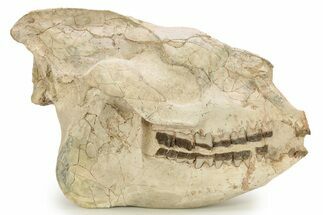This Specimen has been sold.
4" Oligocene Fossil Camelid (Poebrotherium) Mandible - Wyoming
This is a 4" long lower jaw of a camelid (Poebrotherium wilsoni) which was found in Converse County, Wyoming. It is Oligocene in age, or approximately 30 to 34 million years old. Natural teeth are still contained within the jaw, making for a truly beautiful specimen.
There are two repaired cracks through the jaw with some gap fill restoration along the basal surface. Rock has been left in and around the bone to assist with structural integrity of the jaw. The base of the rock has been cut flat for aesthetic presentation.
There are two repaired cracks through the jaw with some gap fill restoration along the basal surface. Rock has been left in and around the bone to assist with structural integrity of the jaw. The base of the rock has been cut flat for aesthetic presentation.
Poebrotherium (meaning "grass-eating beast") is an extinct camelid that roamed North America between the Eocene and Miocene epochs. They were smaller than modern camels, about the same size as a modern sheep, and fit in the place of deer or gazelles in the White River fauna. Despite their name, it is believed that grass was likely not their primary food source but they were instead browsers, feeding on various foliage and berries. Based on bite marks in bones, they were likely preyed on by Archaeotherium, an extinct boar-like entelodont which was also prevalent throughout the White River ecosystem.
SPECIES
Poebrotherium wilsoni
LOCATION
Converse County, Wyoming
FORMATION
White River Formation
SIZE
Jaw: 4" long, Entire Specimen: 3.5 x 3.1 x 2.5"
CATEGORY
SUB CATEGORY
ITEM
#269900
We guarantee the authenticity of all of our specimens.
 Reviews
Reviews













